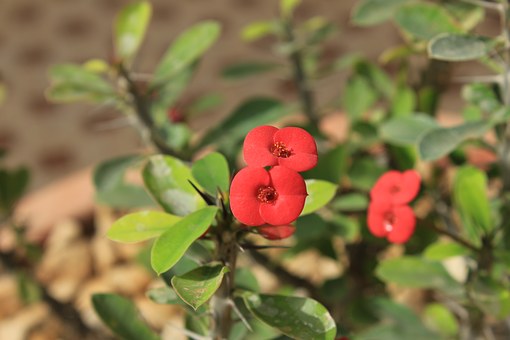Tips on Growing Your Crown Of thorns

The crown of thorns is a garden beauty that is a native of Madagascar that gives that royal touch If you are looking for colors then this garden plant will surely spice up your life. I have worked with the crown of thorns on many garden projects and have never been disappointed. Driving around the country I have seen these garden plants gracing many garden and landscape designs.
There are some crown of thorns that are dwarf, the flowers of the crown of thorns are red and yellow but don’t be fool by these beauties because the name says it all, the crown of thorns are covered with thorns and if you are not careful can leave you with a painful experience so when installing and caring for these plants caution should be taken.
What I love about the crown of thorns is it can withstand the heat and they are drought-tolerant, also the flowers of the crown of thorns are small and fashioned in such a way that really causes this garden beauty to stand out. For more on how to grow the crowns of thorns and where to install them continue reading.
- Planting Location
- Soil Type
- Watering Methods
- Fertilizing Methods
- Garden insect pests of the crown of thorns
- Diseases of the crown of thorns
- Ideas of where to install the crown of thorns
Planting Location
The planting location of the crown of thorns should be an area that gets lots of sunlight.
Soil Type
The soil type should have good drainage, remember these plants are drought tolerant meaning they can survive on small amounts of water if they are planted in a soil that has poor drainage will develop root rot.
Watering Methods
This garden beauty will survive on a small amount of water as stated earlier.
Fertilizing Methods
Fertilize your crown of thorns with a liquid feed that encourages flower bloom. Before applying fertilizers read and follow the manufacturer’s label because the label is the law.
Garden insect pests of the crown of thorns
- Thrips
- Mealybugs
- Aphids
- Scales
Garden insect pests of the crown of thorns are aphids, scales, thrips, and mealybugs. The use of insecticidal soap is a great way to bring these insect pests under control. Before using chemicals read and follow the manufacturer’s label because the label is the law.
Diseases of the crown of thorns
- Bacterial leaf spot
- Plant Mildew
Bacterial leaf spot
Bacterial leaf spot appears as spots that are on the veins of the plant leaves, as the disease progress it produces dead tissues. Bacterial leaf spot is spread from plant to plant from overhead watering that splashes. Applying copper fungicides may offer some help. It is best to remove leaves that are infected and provide the proper spacing for air circulation. Also, sterilize your pruner after pruning procedures.
Plant Mildew
Plant Mildew occurs if the humidity is too high or if the plant is kept too moist. Providing the proper space for air circulation and exposing your crown of thorns to sufficient light will help to prevent this disease or bring this disease under control.
Ideas on where to install crown of thorns
Crown of thorns can be installed.
- As a low grower at the front or spaced out in the middle of your garden bed
- Can be installed along garden walkways
- Can be installed along pathways
- Crown of thorns can be planted along fences, walls, and patios
- On either side of a front door entrance
- Around the trunk of trees
Container grown crown of thorns
When installing crown of thorns in containers it is best to install in containers that have drain holes to allow water to drain. The potting soil should be well-drained soil. Place the container in an area that gets lots of sunlight, when watering your crown of thorns do not soak but give sufficient water to reach the root zone.
Fertilize as stated earlier and keep an eye out for insect pests and treat as discussed earlier. The container can always be moved to a more secure area during heavy rains and the winter frost.
Growing crown of thorns indoors
To grow a crown of thorns indoors the room temperature should be anywhere from 63-75 F. The potting soil should be well-drained soil and the container should have drain holes to allow excess water to drain and a saucer to catch the water. The container should be placed in an area of the house that gets about 4-5 hours of sunlight.
When watering allow the soil to dry out between watering and then give your crown of thorn another drink of water. Fertilize once a month with a liquid feed fertilizer and follow as directed.
Caution
The leaves of the crown of thorns are said to be poisonous so care should be taken where they are installed. Keep these plants out of the reach of children and pets by installing them in a secure area.
The final word
The crown of thorns is a garden beauty that can work wonders. If you are looking for a plant that is low maintenance with a beautiful bloom then the crown of thorn is the plant for you I have seen how these plants can survive the harrases of conditions and still hold up well, easy to grow and maintain the crown of thorn is a must for your garden.
About the author
Norman loves being in the garden, both at home and for his job....
he is 'Natures Little helper' being outdoors, growing his vegetables and flowers from an early age.
Now having spent over 22 years in the profession he want to give some of his knowledge to others...
his vast array of hints and tips you will find scattered over this site will help you no end growing plants in your garden.
